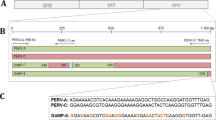Abstract
The discussion about the clinical risk of zoonoses in xenotransplantation has recently culminated in the demand for a moratorium on clinical organ transplantation using pig donors. The basis for this discussion was a recent report showing a possible trans-species transmission of pig endogenous retrovirus (PERV) by in vitro transfer to human cell lines. At present, it remains unclear if this could also happen in vivo or in the setting of xenotransplantation. Potential in vivo transfer of PERV after xenotransplantation was investigated in an experimental pig-to-baboon cell transplantation model. Baboons were immunosuppressed with high-dose cyclophosphamide (total 45–150 mg/kg) and transplanted with primary porcine aortic endothelial cells (PAEC). Tissue samples (skin, lymph nodes, lung) and peripheral blood leukocytes of 15 baboons, taken about 12–24 months after transplantation of PAEC, were then analyzed by PCR and showed no PERV infection. PERV expression in PAEC was also analyzed: PERV mRNA and reverse transcriptase in the culture supernatant could be detected. In spite of the release of retroviral particles from cultured PAEC, transplantation of these cells into baboon recipients did not result in virus transmission, not even under heavy immunosuppression.
Similar content being viewed by others
Author information
Authors and Affiliations
Additional information
Received: 9 March 1998 Accepted: 3 April 1998
About this article
Cite this article
Martin, U., Steinhoff, G., Kiessig, V. et al. Porcine endogenous retrovirus (PERV) was not transmitted from transplanted porcine endothelial cells to baboons in vivo. Transpl Int 11, 247–251 (1998). https://doi.org/10.1007/s001470050136
Issue Date:
DOI: https://doi.org/10.1007/s001470050136




